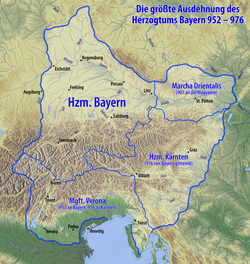Margraviate of Austria
Margraviate of Austria Eastern March Ostarrîchi ( Old High German ) | |||||||||||
|---|---|---|---|---|---|---|---|---|---|---|---|
| c. 970–1156 | |||||||||||
Margrave of Austria | | ||||||||||
• c. 970–976 | Burkhard (first known margrave) | ||||||||||
• 1141–1156 | Henry II (last margrave, and first duke) | ||||||||||
| Historical era | Middle Age | ||||||||||
• Established | c. 970 | ||||||||||
• Disestablished | 1156 | ||||||||||
| ISO 3166 code | AT | ||||||||||
| |||||||||||
The Margraviate of Austria (German: Markgrafschaft Österreich) was a medieval frontier march, centered along the river Danube, between the river Enns and the Vienna Woods (Wienerwald), within the territory of modern Austrian provinces of Upper Austria and Lower Austria. It existed from c. 970 to 1156.[1][2]
It stemmed from the previous frontier structures, initially created for the defense of eastern
At the beginning of the 10th century, the region was raided by
Since 976, it was governed by margraves from the
Name

| History of Austria |
|---|
 |
|
|
In contemporary
Later the march was also called the Margraviate of Austria (German: Markgrafschaft Österreich) or the Bavarian Eastern March (Bayerische Ostmark, the second word being a German translation of marcha orientalis, though no example of this usage in relation to Austria is known before the 19th century). The Bavarian designation is used in historiography in order to differentiate it from the Saxon Eastern March (Sächsische Ostmark) in the northeast. During the Anschluss period of 1938–45 the Nazi authorities tried to replace the term "Austria" with Ostmark.
Geography
The march comprised the lands north and south of the
The initial Babenberger residence was probably at .
The early margraviate was populated by a mix of Slavic and native Romano-Germanic peoples who were apparently speaking Rhaeto-Romance languages, remnants of which remain today in parts of northern Italy (Friulian and Ladin) and in Switzerland (Romansh). In the Austrian Alps some valleys retained their Rhaeto-Romance speakers until the 17th century.
History

Background
The first marches covering approximately the territory that would become
Margraviate
In 955, King
Margravial Austria reached its greatest height under
See also
- History of Austria
- Pannonian March
- Avarian March
- Hungarian March
Notes
- ^ Pohl 1995, pp. 64, 154.
- ^ Reuter 2013, pp. 194.
- ^ Bowlus 1995.
- ^ Goldberg 2006.
- ^ Alois Schmid (Hrsg.): Handbuch der bayerischen Geschichte. Bd. 1: Das Alte Bayern. Teil 1: Von der Vorgeschichte bis zum Hochmittelalter. Verlag C. H. Beck, München 2017, ISBN 978-3-406-68325-1, S. 277f., 286
- ^ Reuter 2013, pp. 158, 194.
- ^ The March of Moravia as a separate entity came into existence in 1182. There was no colonisation in Moravia run by Austrian dukes in the 11th century (nor later). In the first half of 11th century Moravia was conquered from the Magyars and Poles and reunited with Bohemia by prince Oldřich.
References
- Bowlus, Charles R. (1995). Franks, Moravians, and Magyars: The Struggle for the Middle Danube, 788-907. Philadelphia: University of Pennsylvania Press. ISBN 9780812232769.
- Goldberg, Eric J. (2006). Struggle for Empire: Kingship and Conflict under Louis the German, 817-876. Ithaca, NY: Cornell University Press. ISBN 9780801438905.
- Pertz, Georg Heinrich, ed. (1845). Einhardi Annales. Hanover.
- ISBN 9783222123344.
- ISBN 9781317872399.
- Scholz, Bernhard Walter, ed. (1970). Carolingian Chronicles: Royal Frankish Annals and Nithard's Histories. University of Michigan Press. ISBN 0472061860.

